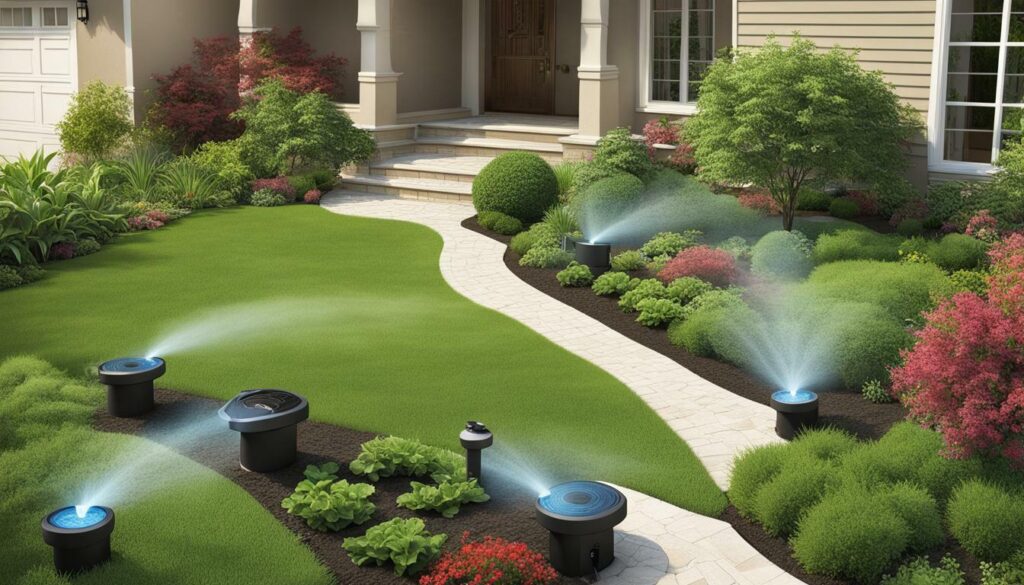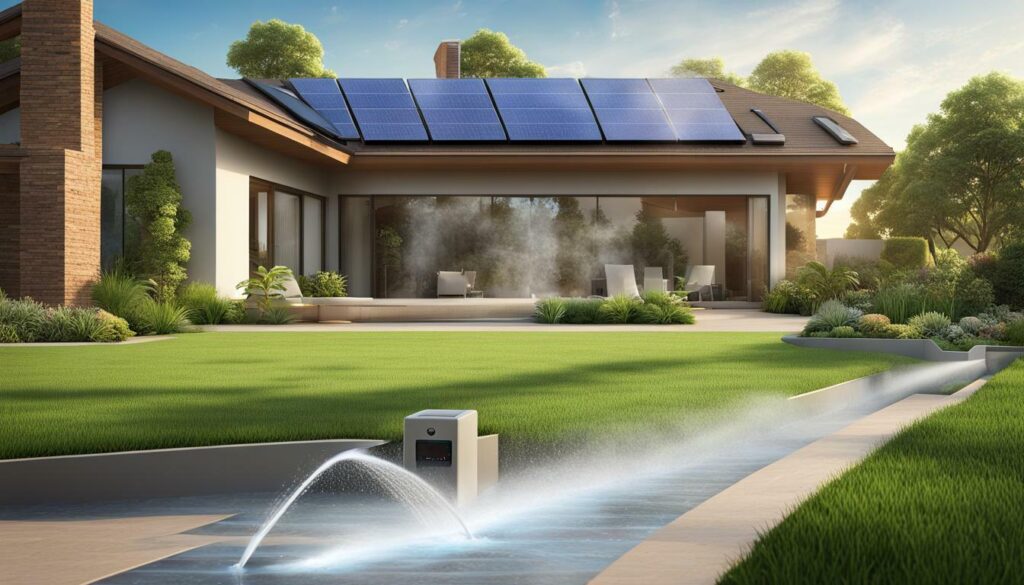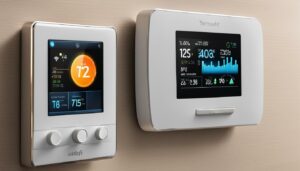If you’re tired of manually watering your lawn or garden, it’s time to discover the wonders of automated irrigation systems. These innovative technologies are transforming lawn care routines, making them more efficient, time-saving, and cost-effective. With automated irrigation systems, you can enjoy lush and healthy greenery without any hassle.
Popular brands like Amazon Echo, Google Nest, and SmartThings offer advanced automated irrigation systems that can be controlled with voice commands or smartphone apps. You can set watering schedules, adjust settings, and monitor your irrigation system’s performance from anywhere, at any time. Other brands like Blink, Ring, TP-Link, and Arlo offer smart watering systems and automated sprinkler systems that use cutting-edge technologies to optimize water usage and save you money.
Key Takeaways:
- Automated irrigation systems are revolutionizing lawn care routines.
- Popular brands like Amazon Echo, Google Nest, and SmartThings offer advanced automated irrigation systems that can be controlled with voice commands or smartphone apps.
- Other brands like Blink, Ring, TP-Link, and Arlo offer smart watering systems and automated sprinkler systems that use cutting-edge technologies to optimize water usage and save you money.
Understanding Automated Irrigation Systems
Automated irrigation systems, also known as smart watering systems and automated sprinkler systems, are revolutionizing the way we care for our lawns. These systems are designed to water your garden in a precise and efficient way, saving you time, water, and money.
Smart watering systems are controlled by sensors that monitor soil moisture levels, local weather conditions, and other factors to determine the most optimal watering schedule. Automated sprinkler systems, on the other hand, are programmed to water specific areas of your garden at certain times, with customizable settings for different plants and soil types.
With the rise of smart home technology, many automated irrigation systems can now be controlled remotely through apps or voice assistants like Amazon Echo, Google Nest, and SmartThings. This means you can adjust your watering schedule or turn off your sprinklers from anywhere, giving you even more control over your landscape.
Popular brands in the automated irrigation market include Blink, Ring, TP-Link, and Arlo, each with their unique features and technologies that make them stand out. By understanding how these systems work, you can take advantage of the advanced technologies and capabilities they offer and achieve a beautiful, healthy lawn with minimal effort.

Creating a Smart Garden with Automated Irrigation Systems
Automated irrigation systems offer a great opportunity for homeowners to create a smart garden setup that caters to their needs.
With smart garden irrigation, you can connect your automated irrigation system to other smart home devices like Amazon Echo, Google Nest, and SmartThings to keep your lawn healthy and beautiful without lifting a finger. This integration helps improve the overall look of your garden without the hassle of manually operating your sprinkler system.
The advanced irrigation technologies available in popular brands like Blink, Ring, TP-Link, and Arlo provide customizable settings and remote-controlled capabilities that make watering your garden a breeze.
But what makes the smart garden irrigation truly smart is the ability to connect the irrigation system to other smart home devices like Wink, Wyze, SimpliSafe, and Philips Hue. This integration creates a cohesive and automated landscape that is both beautiful and functional.
Imagine your garden lighting up as the sun sets and the irrigation system kicking in just as the weather starts to change. This synchronized functioning can help you save time and money while catering to your garden’s watering needs.
So, if you want to take your garden to the next level, consider integrating advanced irrigation technologies with other smart home functionalities to create a beautiful and automated landscape that is sure to impress.

Water-Saving Benefits of Automated Irrigation Systems
One of the most significant advantages of automated irrigation systems is their ability to conserve water. By utilizing advanced technologies like weather sensors and soil moisture monitors, these systems optimize water usage and reduce waste, which is good for the environment and your wallet. By investing in a water-saving irrigation system, you can enjoy a lush, healthy lawn while minimizing your water usage and bill.
These systems use real-time data to adjust watering schedules, ensuring that your lawn and garden receive the right amount of water at the right time. For instance, if there’s been a recent rainfall, the system can skip a watering cycle until the soil dries out. This feature alone can significantly reduce water usage.
Moreover, many automated irrigation systems use drip irrigation, which conserves water by directly delivering moisture to plants’ roots, minimizing evaporation and runoff. With drip irrigation, you can reduce water usage by up to 50% compared to traditional sprinkler systems. For environmentally conscious homeowners, this is a great way to minimize your carbon footprint and support sustainable landscaping practices.
| Brand | Water-Saving Features |
|---|---|
| August | Weather-based watering adjustments |
| Lutron | Customizable watering schedules |
| Insteon | Soil moisture sensors |
| Abode | Drip irrigation technology |
If you’re passionate about sustainable and eco-friendly practices, a water-saving irrigation system should be at the top of your list. Not only will you reduce your water usage and bill, but you’ll also be doing your part to support the environment.

Smart Home Integration and Energy Efficiency
Automated irrigation systems can be seamlessly integrated into your smart home ecosystem. These systems are compatible with popular platforms such as Ecobee, Rachio, and Orbit, allowing you to control your sprinkler system with voice commands or through the convenience of a mobile app.
Not only do these systems save you time and water, but they are also energy efficient. Automated irrigation controllers adjust watering schedules based on real-time weather and soil moisture data, reducing unnecessary water usage and saving energy. As a result, you can enjoy a lush and healthy lawn without having to worry about excessive water bills.
By combining advanced irrigation technologies with other smart home functionalities, you can create a sustainable and environmentally friendly landscape. Whether you have a large garden or a small front yard, a smart watering system can help you save resources and make your home more efficient.

Conclusion
Automated irrigation systems are revolutionizing lawn care with their advanced technologies and water-saving capabilities. With popular brands like Amazon Echo, Google Nest, and SmartThings, these systems are becoming more accessible and user-friendly.
By understanding how smart watering systems and automated sprinkler systems work, you can take advantage of customizable settings and remote-controlled capabilities. Blink, Ring, TP-Link, and Arlo are some of the brands leading the way in this industry.
Integrating automated irrigation systems into a smart garden setup can create a cohesive and automated landscape. Connect your system to other smart home devices like Wink, Wyze, SimpliSafe, and Philips Hue for even more advanced functionality.
Water-saving irrigation systems like August, Lutron, Insteon, and Abode optimize water usage by adjusting watering schedules based on weather conditions and soil moisture levels. This not only leads to environmental benefits but also financial ones.
Consider integrating automated irrigation systems into a broader smart home ecosystem compatible with popular platforms like Ecobee, Rachio, and Orbit. These systems contribute to overall sustainability and energy efficiency.
Upgrade your lawn care routine today with automated irrigation systems and experience the time and resource-saving benefits for yourself.
FAQ
Q: What are the benefits of automated irrigation systems?
A: Automated irrigation systems save time, water, and money. They provide convenience by allowing remote-controlled capabilities and customizable settings.
Q: How do automated irrigation systems work?
A: Automated irrigation systems, such as smart watering systems and automated sprinkler systems, utilize advanced technologies to optimize water usage. They adjust watering schedules based on weather conditions and soil moisture levels. These systems can be controlled remotely and offer customizable settings.
Q: Can automated irrigation systems be integrated into a smart garden setup?
A: Yes, automated irrigation systems can be connected to other smart home devices like Wink, Wyze, SimpliSafe, and Philips Hue to create a cohesive and automated landscape. This integration allows for the efficient and synchronized operation of all smart home functionalities.
Q: How do automated irrigation systems save water?
A: Automated irrigation systems optimize water usage by adjusting watering schedules based on real-time weather conditions and soil moisture levels. This water-saving feature helps conserve water resources and reduces water bills.
Q: Can automated irrigation systems be integrated with other smart home devices?
A: Yes, automated irrigation systems can be integrated into a broader smart home ecosystem. They are compatible with popular smart home platforms like Ecobee, Rachio, and Orbit. These systems contribute to energy efficiency and overall sustainability.
Q: What is the importance of considering automated irrigation systems for lawn care?
A: Automated irrigation systems revolutionize lawn care routines by providing time and resource savings. They offer convenience, water-saving benefits, and the ability to integrate with other smart home devices.




